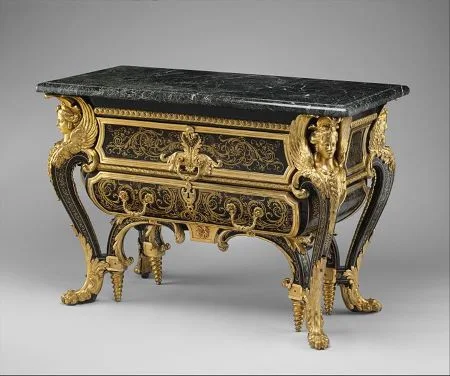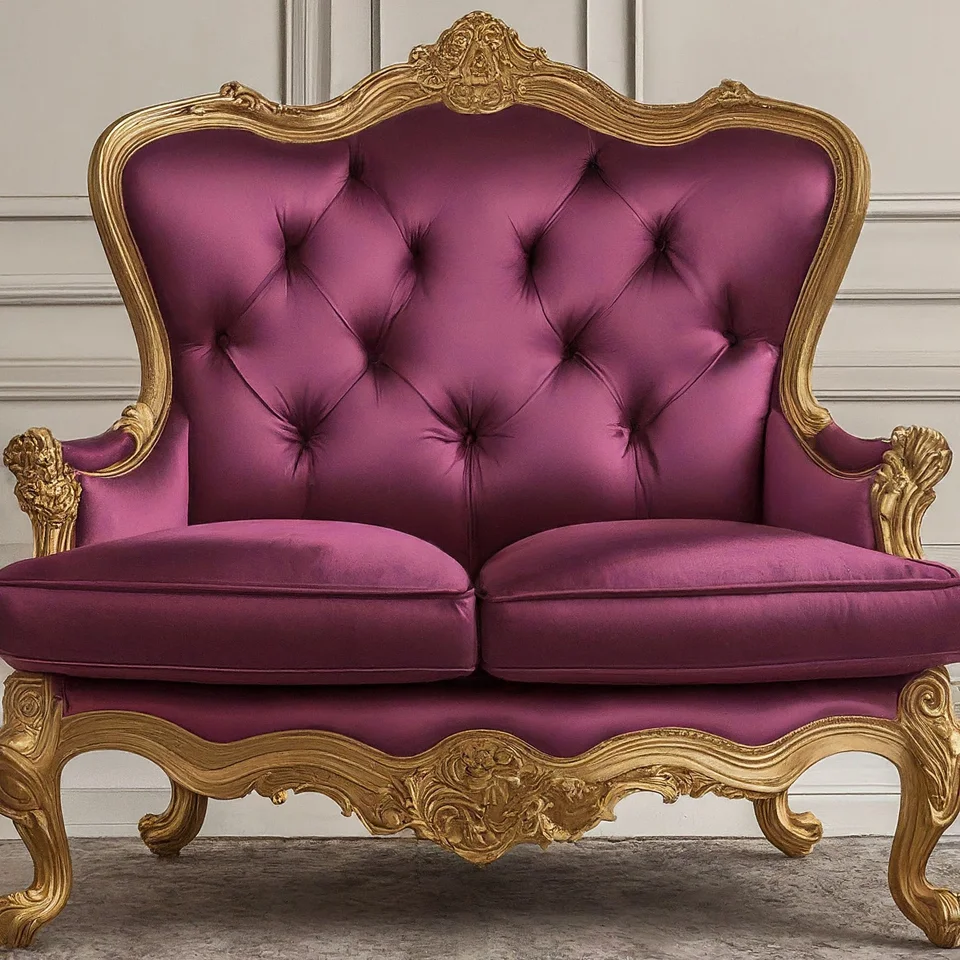Defining the Charming Rococo Furniture Style
Step into the enchanting world of Rococo furniture style, where opulence meets frivolity, and elegance dances with fancy. Rococo emerged as a reaction to the grandeur of the preceding Baroque Era. This ornate and graceful aesthetic captivated the hearts of Europe's elite, leaving an indelible mark on interior design history.
If you're a fan of intricate details, whimsical curves, and luxurious elegance, then the rococo furniture style might just be right up your alley. Originating in France in the 18th century, Rococo is characterized by ornate decorations, asymmetrical designs, and a sense of opulence. In the world of interior design, rococo furniture adds a touch of romance and drama to any room.
 |
| Wealthy baroque table, Photo: study.com |
In this blog post, we delve into the captivating allure of Rococo furniture style, exploring its origins, defining its characteristics, and enduring influence on interior design in general. So, if you're curious to learn more about the charm of this furniture style and how to incorporate it into your own home, keep on reading!
Glance on its History and Emergence
The source of Rococo can be traced back to the early 18th century, as mentioned earlier; A time of cultural and artistic evolution in Europe. As society shifted away from the rigid formalism of the Baroque period, a new aesthetic emerged—one characterized by lightness, asymmetry, and playful elegance.
- The term "Rococo" itself is believed to have originated from the French word "rocaille," meaning shellwork or rockwork, reflecting the style's affinity for organic motifs inspired by nature.
Rococo style flourished during the reign of King Louis XV of France, who ascended to the throne in 1715. Under his patronage, artists and craftsmen embraced the Rococo aesthetic, infusing their creations with a sense of grace and fantasy.
Furniture makers such as François Cuvilliés and Thomas Chippendale became interchangeable with the Rococo style, crafting exquisite pieces that adorned the palaces and salons of the aristocracy.
Characteristics of Rococo Furniture Style
At the heart of Rococo furniture lies a celebration of curvaceous forms, intricate ornamentation, and delicate craftsmanship. Unlike the symmetrical rigidity of Baroque design, Rococo embraces asymmetry, with sinuous lines and organic motifs dominating its aesthetic vocabulary.
Elaborate scrolls, floral motifs, and fanciful depictions of cherubs and shells adorn Rococo furniture, infusing each piece with a sense of whimsy and romance. One of the defining features of Rococo furniture is its emphasis on comfort and intimacy. Read more >
Chairs and sofas are often upholstered in luxurious fabrics such as silk and velvet, inviting occupants to recline in opulent splendor. Cabriole legs, characterized by their graceful S-shaped curves, lend a sense of movement and dynamism to Rococo furniture, while gilded accents add a touch of decadence and refinement. (See Image below)
 |
| Fascinating wealthy chair in Rococo style, Photo generated with AI. |
How Does the Rococo Differ from the Baroque Style?
Baroque and Rococo styles are often mentioned in the same breath due to their chronological proximity and shared European origins, but they represent distinct periods in the evolution of art and design.
Baroque style emerged in the late 16th century and reached its peak in the 17th century, preceding Rococo by about a century. It was characterized by grandeur, drama, and a sense of movement, reflecting the Catholic Church's desire to inspire awe and piety in its followers.
Baroque architecture and art featured elaborate ornamentation, bold contrasts of light and shadow (known as chiaroscuro), and monumental scale. Rococo, on the other hand, emerged in the early 18th century as a reaction against the formalism and rigidity of the Baroque style — already mentioned in the introduction above. It embraced a lighter, more playful aesthetic, characterized by asymmetry, delicate ornamentation, and a sense of whimsy.
While Baroque design was often characterized by its grandiosity and theatricality, Rococo design was more intimate and ornamental, with an emphasis on comfort and elegance. However, one key difference between the two styles lies in their approach to ornamentation.
Baroque design tended towards a more structured and monumental use of ornamentation, often featuring elaborate sculptural elements and intricate detailing. In contrast, Rococo's design favored a more delicate and organic approach to ornamentation, with motifs inspired by nature such as shells, scrolls, and flowers.
Another distinction is in their treatment of space. Baroque architecture and interiors often featured expansive, soaring spaces designed to evoke a sense of awe and majesty, while Rococo interiors were characterized by their smaller scale and emphasis on intimacy and comfort. Rococo rooms were often arranged to facilitate social interaction and conversation, with furniture arranged in smaller groupings rather than along the walls.
Overall and in summary, while Baroque and Rococo styles share some common elements, such as ornate ornamentation and a focus on luxury, they represent distinct artistic movements with their own unique characteristics and influences. Baroque is known for its grandeur and drama, while Rococo is celebrated for its lightness, elegance, and whimsical charm.
Influence on Interior Design
The influence of the Rococo furniture style extends far beyond the confines of the 18th century, leaving an indelible mark on interior design for centuries to come. During its heyday, it saturated every aspect of elite society, from grand palaces to intimate salons.
The whimsical charm and elegance of Rococo furniture captivated the imaginations of Europe's elite, shaping the way they lived, socialized, and entertained. In the realm of interior design, this style ushered in a new era of opulence and extravagance.
Lavish chandeliers illuminated sumptuously decorated salons, while gilt-framed mirrors reflected the splendor of the surrounding décor. Rococo interiors were a feast for the senses, with richly textured fabrics, ornate wall coverings, and intricately carved furniture creating an atmosphere of luxury and refinement.
Despite its association with the aristocracy, it also exerted a democratizing influence on interior design, inspiring a proliferation of imitations and adaptations for the burgeoning middle class. By the mid-18th century, Rococo motifs had permeated popular culture, appearing on everything from porcelain figurines to wallpaper patterns. This democratization of design allowed individuals of all social classes to partake in the whimsical allure of the Rococo style, albeit in more modest forms.
Revival and Contemporary Interpretations
Although the heyday of Rococo design may have passed, its legacy continues to resonate in the world of interior design today. Revivals of the style periodically emerge as designers and tastemakers draw inspiration from its exuberant aesthetic. From haute couture to home furnishings, the influence of Rococo can be seen in the playful use of curves, the incorporation of ornate detailing, and the celebration of luxury and indulgence.
Contemporary interpretations of the style often blend elements of tradition with a modern sensibility, creating spaces that are at once timeless and of the moment. Velvet-upholstered sofas mingle with sleek, minimalist furnishings, while gilded accents add a touch of glamour to pared-back interiors. By reimagining Rococo for the 21st century, designers pay homage to a bygone era while infusing their creations with a sense of vitality and relevance.
Last, the Rococo furniture style remains a shining beacon of elegance and whimsy in the ever-evolving tapestry of interior design history. From its origins in 18th-century France to its enduring influence on contemporary design, Rococo continues to captivate and inspire with its opulent charm.
Whether adorning the halls of a grand palace or the living room of a modern home, the Rococo furniture style invites us to indulge in the beauty of the past while embracing the possibilities of the future.
